
Giovanni Giuseppe Gilberto "Nanni" Galli was an Italian saloon, sports-car and Formula One driver of the 1960s and 1970s.

Arturo Francesco "Art" Merzario is an Italian racing driver and motorsport executive, who competed in Formula One from 1972 to 1979.
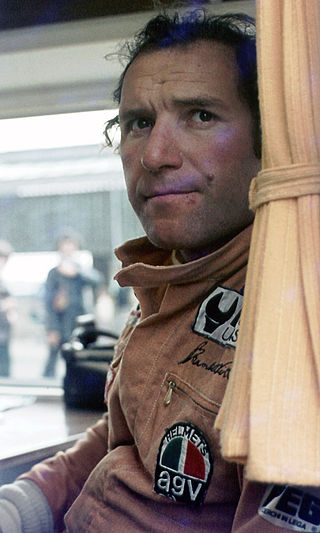
Vittorio Brambilla was an Italian racing driver, who competed in Formula One from 1974 to 1980. Nicknamed "The Monza Gorilla", Brambilla won the 1975 Austrian Grand Prix with March.
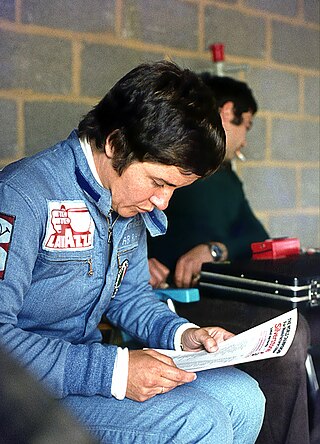
Maria Grazia "Lella" Lombardi was an Italian racing driver who participated in 17 Formula One World Championship Grands Prix. Lombardi is one of two female drivers to qualify for Formula One and is the only female driver who scored points in Formula One.

Kauhsen was a Formula One constructor from Germany, founded by former sportscar driver Willi Kauhsen. The team started in Formula Two in 1976, purchasing Renault cars, and raced with an assortment of drivers with limited success. Kauhsen then entered the 1979 Formula One season, spending 1978 designing their own chassis with Cosworth engines. They participated in two World Championship Grands Prix with Gianfranco Brancatelli, failing to qualify on both occasions, before the team was shut down.

Frank Williams Racing Cars was a British Formula One team and constructor.
The Alfa Romeo Tipo 33 was a sports racing prototype raced by the Alfa Romeo factory-backed team between 1967 and 1977. These cars took part for Sport Cars World Championship, Nordic Challenge Cup, Interserie and CanAm series. A small number of road going cars were derived from it in 1967, called Alfa Romeo 33 Stradale.
The 1976 World Sports Car Championship was a motor racing series open to Group 6 cars,. The championship was contested over a seven race series which ran from 4 April to 19 September and included a secondary award, the 1976 FIA Cup for Cars up to 2 Litres. 1976 was the 24th season of FIA World Sportscar Championship racing.
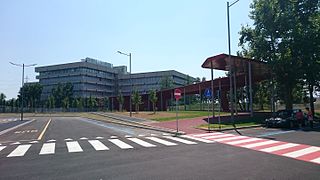
Museo Storico Alfa Romeo is Alfa Romeo's official museum, located in Arese (Milan), and displaying a permanent collection of Alfa Romeo cars and engines.
Centenari Racing SRL, usually referred to as Centenari, was an Italian racing team and chassis constructor company based in Italy, predominantly building sports prototypes. The team were active in international events between 1997 and 2006, having started off in national events in 1991.
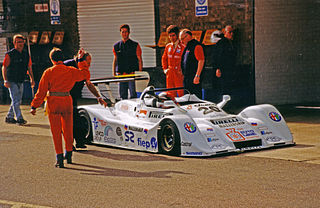
The Centenari M1 was a Le Mans Prototype, originally built by Centenari in 1991 for the Italian Prototype Championship. In 1997 and 1998, it was used in the SR2 and the CN category of the International Sports Racing Series. Two cars are known to have been built.

Willibert "Willi" Kauhsen is a German former racing driver and racing team owner from Eschweiler in Aachen, Germany.
Martino Finotto was an Italian racing driver, mainly known for his success in touring car and sports car racing.
The Catania-Etna is a car competition, more precisely a hillclimb, which takes place annually in province of Catania. It is valid for the Cronosprint Trophy. It is organized by the Automobile Club d'Italia of Catania.

The Abarth 3000 Sport Prototipo was a sports car prototype made by Abarth & C. in Turin, Italy. It was the first Abarth with an engine with a capacity of more than 2-liters, after an already finished 6-liter twelve-cylinder from 1967 had become useless before it could be used due to a change in the regulations. The displacement for sports car prototypes was limited to 3 liters and for sports cars to 5 liters.
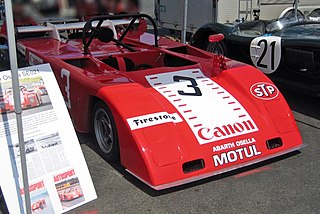
The Abarth-Osella 2000 Sport SE-021 is a mid-engined, Group 5, prototype race car, built by Osella to compete in the World Sportscar Championship sports car racing series in 1972, and for some races in 1973. The chassis itself was developed and developed by Osella, while the car itself was powered by a 2.0 L (120 cu in) Abarth four-cylinder engine, generating a healthy 265 hp (198 kW). Since the light and nimble chassis only weighed 530 kg (1,170 lb), this gave it an incredible power-to-weight ratio. It was entered 39 times in races, and had 10 podiums. It scored 8 wins in its career.
The Osella PA2 is a 2-liter Group 5 prototype racing car built by Osella, to compete in the World Sportscar Championship sports car racing series from 1974 to 1975, but was used in active competition IMSA GT Championship until the end of 1985. It was initially powered by either the 2.0 L (120 cu in) Abarth twin-cam engine, or later, the BMW M12/7 Turbo engine. It scored a total of 3 wins, and 6 podiums. The type was entered 63 times.

The Osella PA6 and Osella PA7 are Group 6 prototype racing car designed, developed, and built by Osella, to compete in the World Sportscar Championship sports car racing series between 1978 and 1982. It was powered by a number of different engines, including the 2.0 L (120 cu in) BMW M12/7 and the Cosworth BDG, and the 1.6 L (98 cu in) Cosworth FVA was also used. After retiring from sports car racing, these cars later competed in hillclimb racing.

The Osella PA9 was a 2-liter, Group 6, sports car prototype, developed in 1981 by the Turin racing car manufacturer Osella and used by the factory in sports car and hill climb races until 1988.

The Ferrari 712P is a purpose-built Group 7 prototype, designed, developed and built by Scuderia Ferrari specifically designed to compete in Can-Am sports car races from 1970 to 1974. The 7 refers to the displacement of the engine in liters, the 12 refers to the number of cylinders, and the P stands for Prototype.





















